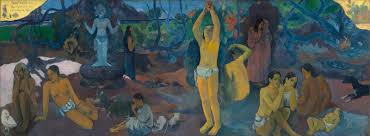Human Nature and Human Destiny
TRANSCEND MEMBERS, 19 Feb 2018
John Scales Avery – TRANSCEND Media Service
19 Feb 2018 – When he was between the ages of 11 and 16, Paul Gauguin attended a Catholic boarding school in France. At the school, the Bishop of Orléans himself taught the class in liturgy. The bishop had devised a catechism in which three main questions were asked: “Where does humanity come from? Where is it going? How do we proceed?”
It is possible that these questions influenced Gauguin when, many years later, he began an enormous painting whose title asked very similar questions. By this time Gauguin had become an influential post-impressionist artist, the leader of the symbolist movement. Gauguin was admired by a small circle of artists but, like his close friend Vincent van Gogh, he was unrecognized by the larger public until after his death.
In 1891, when he began the the huge painting, Gauguin was living on the island of Tahiti, where he had gone in search of a society free from European prejudices. Dogged by failing health and financial worries, he planned to commit suicide after finishing what he regarded as his best painting. He did, indeed, attempt suicide by taking an overdose of arsenic, but the attempt failed, and he lived until 1903.
Gauguin’s famous painting can symbolize the questions that humans throughout the ages have asked. Is there a purpose to life? What is our place in nature? Is the earth the center of the universe? What will happen in the future? Are humans special, or are the similar to other animals? Is human nature good or evil? Why do we sometimes act with loving care, and at other times commit genocides? Can war be eliminated? Both science and religion have proposed answers to these central questions.
Most thoughtful observers today believe that human civilization is entering a period of crisis. As all indices move exponentially upward, including population, industrial production, scientific development and the power of technology over nature, the problem of achieving a stable and peaceful world remains serious, challenging and unsolved.
Can humanity and the biosphere survive today’s explosive growth of population and industry? Can we escape the twin threats of catastrophic climate change and thermonuclear war? Can we avoid a large-scale famine caused by population growth, climate change and the end of the fossil fuel era? Where do we come from? What are we? Where are we going?
Regardless of whether the earth has a special importance when viewed on the scale of our fathomless universe, it is certainly important to us, and to the plants and animals with which we share the gift of life. None of us would wish to see a fatally damaged earth or a dystopian future. We give loving care to our children, but it makes no sense to do so if we neglect to do all that is within our power to give them a future in which they and their descendants can survive.
None of us asked to be born into an age of crisis, but history has given an enormous responsibility to our generation. In addition to the ordinary work that we do in order to put bread on the table and pay the rent, each of us has another job: We must work with dedication to save the future.
I have written a book exploring these questions. It is available for free downloading and circulation on the following link at the school, the Bishop Dupanloup of Orlìan:
http://www.fredsakademiet.dk/library/where.pdf
____________________________________________
 John Scales Avery, Ph.D., who was part of a group that shared the 1995 Nobel Peace Prize for their work in organizing the Pugwash Conferences on Science and World Affairs, is a member of the TRANSCEND Network and Associate Professor Emeritus at the H.C. Ørsted Institute, University of Copenhagen, Denmark. He is chairman of both the Danish National Pugwash Group and the Danish Peace Academy and received his training in theoretical physics and theoretical chemistry at M.I.T., the University of Chicago and the University of London. He is the author of numerous books and articles both on scientific topics and on broader social questions. His most recent books are Information Theory and Evolution and Civilization’s Crisis in the 21st Century (pdf).
John Scales Avery, Ph.D., who was part of a group that shared the 1995 Nobel Peace Prize for their work in organizing the Pugwash Conferences on Science and World Affairs, is a member of the TRANSCEND Network and Associate Professor Emeritus at the H.C. Ørsted Institute, University of Copenhagen, Denmark. He is chairman of both the Danish National Pugwash Group and the Danish Peace Academy and received his training in theoretical physics and theoretical chemistry at M.I.T., the University of Chicago and the University of London. He is the author of numerous books and articles both on scientific topics and on broader social questions. His most recent books are Information Theory and Evolution and Civilization’s Crisis in the 21st Century (pdf).
This article originally appeared on Transcend Media Service (TMS) on 19 Feb 2018.
Anticopyright: Editorials and articles originated on TMS may be freely reprinted, disseminated, translated and used as background material, provided an acknowledgement and link to the source, TMS: Human Nature and Human Destiny, is included. Thank you.
If you enjoyed this article, please donate to TMS to join the growing list of TMS Supporters.

This work is licensed under a CC BY-NC 4.0 License.

Thanks John. I’ve downloaded your book and it looks very interesting. I’m really looking forward to reading it.
Thank you, John Scales Avery–for your thoughts here, your inspiration, and for all the great work you have done throughout the years! The Bishop in Gaugin’s childhood, and, later, Gaugin himself asked those life-essential questions.
I had the good fortune to see the painting, on loan, at a museum in Boston some years ago. The imagery is familiar to many, and is easily manifested through the wizardry of the Internet.
It is so important to pause, to catch our breath, to contemplate great art and great teachers. The business and busyness of our modern world dissuades us from such crucial contemplation. (Thank you, John–and Paul!–for calling us back!)
Beginning with a baby asleep (perhaps dreaming) in the right, bottom corner, the painting takes us through a metaphorical journey from infancy, into the sensuous, sexual world, past what appear to be dark angels, past an image of a stony god, to a withered, old woman in the left, bottom corner–a dove, apparently, pluming itself at her feet.
I think many of us are now feeling this same sense of wondering and bewilderment. Like the central figure in the painting, we have reached for and plucked the fruits of desire–for a better world, a saner world, a more humane and “civilized” world, wandering past the shadowy figures of mysticism, past the blue idol of a god, to the “last full measure of devotion”–a doubting figure wondering what it all meant–the ecstasies of revolutionary times, youthful hopes and dreams.
Of course, I have no solid answers…. Even God, speaking out of the Whirlwind, really had no satisfactory answer. Something like: Endure; suffer; get through it; you may come to understand, and then again, you may not.
“Man must suffer to be wise,” great Aeschylus wrote. We really have no choice but to continue on the journey, to ask the vital questions, to seek counsel, to share with comrades what we have gained and what we have lost.
The historical record has been dismal (even abysmal) in terms of the warmongers vs. the peace-mongers. There may be one glimmer of hope for our species. It is a very faint light on the horizon: We are much more connected than ever. In spite of the Internet trolls, in spite of the imbecilic politicians and the Hyde-drooling war-profiteers, we can learn and teach so that we do not (to paraphrase Santayana) fail to learn the lessons of the past…and repeat them! I’m not Pollyannaish! I know it is a faint light and there are many whirlpools to navigate.
How do we make new connections? We are less than 5 minutes away from midnight on the Doomsday Clock! We had better get our house in order, and ponder the words Lincoln quoted from the (sometimes) “Good Book”: “A house divided against itself cannot stand.”
Is there a way to syncretize our best aspirations, our highest goals and principles. Out of Hegelian thesis and antithesis, can we derive a new synthesis of values and wisdom?
Can the dove in the corner of Gaugin’s masterpiece take flight?